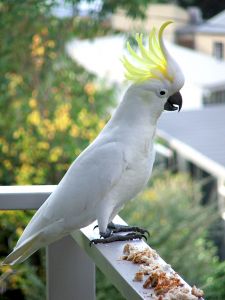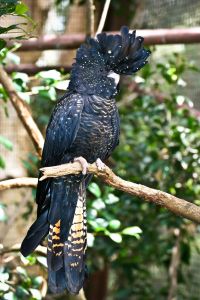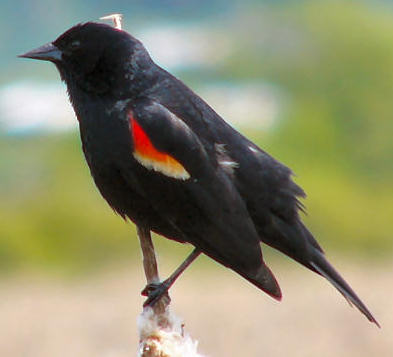Cockatoo
The cockatoo is a general term used to describe any of the 21 species that belongs to the bird family called Cacatuidae. Along with the Psittacidae (true parrots) and the Strigopidae (New Zealand parrots), they make up the parrot order, Psittaciformes. The members of the cockatoo family are distriburted in mostly Australasia, rangng from the Philippines and the east Indonesian islands of Wallacea, to New Guinea, the Solomon Islands, and Australia. The name of the cockatoo is said to hav eoriginated from the Malay name of these birds, which is kaka(k)tua (kaka “parrot” + tuwah “older sister” or from the words kakak “sister” + tua “old”).
Cockatoos are easily recognisable by their curved bills and showy crests. On average, cockatoos are larger than parrots. Their plumage is less colourful than parrots, with their plumage being black, grey, or white. They also have coloured feathres in their tail, cheeks, or crests.
The diet of cockatoos are omnivorous. They usually eat seeds, tubers, corms, flowres, fruit, and insects. They feed in large flocks especially during ground feeding. They are monogomous creatures that nest in tree hollows. Sadly, some cockatoo species have been badly affected by the loss of their habitat, especially as suitable nesting hollows from mature, large trees are cleared. However, some species have adapted well to changes made by humans but are actually considered agricultural pests.
Cockatoos are popular house pets, despite the fact that their needs are difficult to cater for. The Cockatiel is much easier to keep as a pet and therefore is the most popular to keep at home. White cockatoos in particular are found in captivity rather than black cockatoos.
According to both the IUCN and BirdLife International, 8 cockatoo species are categorised as being vulnerable or worse. One species is considered to be near threatened. The Yellow-crested Cockatoo and the Red-vented Cockatoo are both considered as critically endangered. Sadly, the reasons for this are mostly human-related. Their main threats are the loss of their habitat, as well as the wildlife trade. As mentioned above, cockatoos require trees for nesting. They are also popular to keep as pets, so the capture and trade of some species have sadly made these animals threatened. For example, during 1983 to 1990, over 66,600 Salmon-crested Cockatoos were exported from Indonesia.
However, this does not include any birds caught for the domestic trade or illegally. Although the capture of many species have been now banned, the trade still continues illegally. Birds are put in bamboo tubes or in crates and carried out on boats out of the Philippines and Indonesia. Sadly, rare species are actually smuggled outside of Indonesia to Australia. The cockatoos are sedated before being covered in nylon stockings, packed into PVC tubing, then placed in unaccompanied luggage on international flights. The mortality rate is high at 30%, and eggs which are more easily hidden on smugglers’ bodies are increasingly smuggled instead. Bird trafficking is thought to be run by organised gangs.




